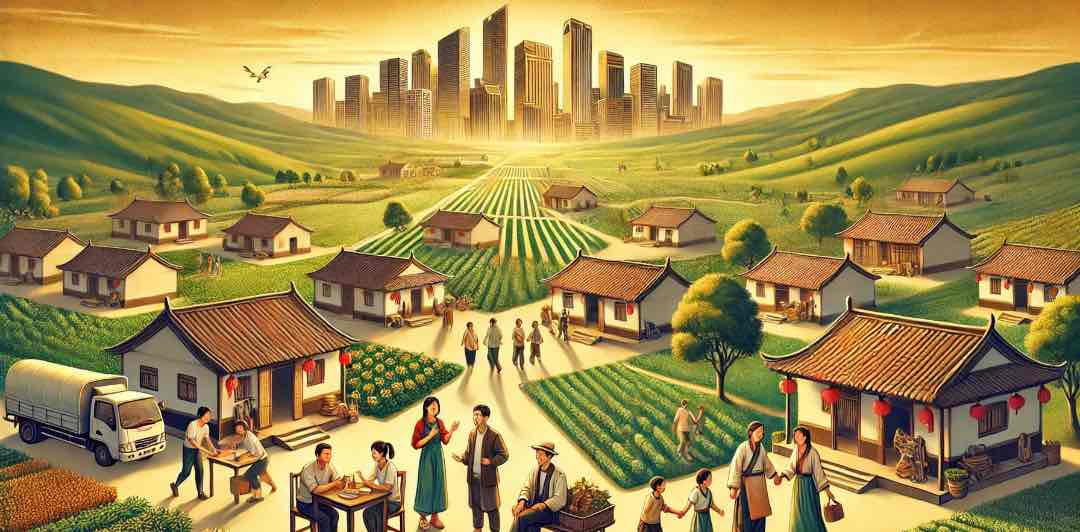
Today is the second day of the Chinese New Year. First of all, I wish you a happy Spring Festival! I wonder if you will go back to your hometown to visit relatives in the next two days.
Today’s topic is: Now all places have opened up policies to allow urban residents to move their household registration to rural areas. Please pay attention to my wording, it is allowed.
After decades of moving from rural areas to cities, why do urban residents, especially those in small and medium-sized cities, want to return to rural areas? Is rural household registration an opportunity with dividends? A new social convection, that is, resources and population will flow and redistribute? Today we will dismantle these issues.
After “agricultural to non-agricultural”, why do we need to change back to rural household registration?
Let me start with a specific example. In December 2024, Qinhuangdao issued the “Implementation Opinions on Further Deepening the Reform of the Household Registration System and Improving the Rural Settlement Policy in Qinhuangdao City”, which will be implemented from January 1, 2025.
According to the regulations, people with urban household registration who meet certain conditions can choose to move their household registration to the countryside. There are a total of ten situations, such as couples seeking refuge, retired soldiers, children seeking refuge, etc., which are common situations. However, the document also details several special situations:
First, college and technical school students who moved their household registration out for study can directly apply to move back to the countryside.
Second, those who moved out for marriage can move back to the countryside after divorce for 3 years or widowhood.
Third, college graduates, vocational school graduates, returned overseas students, and talents urgently needed for rural revitalization can settle in rural areas where they are employed and start businesses.
Of the three items above, the second and third items require the consent of the village committee, but the first item does not.
Why do these situations make people feel more or less surprised? Because our policy in the past has always been: the urbanization of farmers. That is, guiding the rural population to move to the city to promote urban development. The tide of rural population moving to the city in the past 20 years has objectively promoted the process of industrialization and urbanization in my country and is the underlying foundation for economic take-off. For the rural population, urban household registration is tied to a series of benefits such as employment opportunities, educational resources, medical care, and social security. Especially in underdeveloped areas, the difference between urban and rural household registration is more significant. Therefore, “leaving the farm” and realizing “agricultural to non-agricultural” means that the agricultural population is transformed into non-agricultural population, which has become the aspiration of several generations of rural people.
However, with the development of the times, the gap between the urban and rural dual household registration is gradually being leveled, and even in some cases, it has reversed: the cost of living, rhythm pressure, employment involution, resource overload and other problems in the city have begun to emerge. In a word, the new opportunities are not as good as the new costs, and the cost performance is not high. On the contrary, some developed rural areas are relatively less involutionary and have low talent density. In contrast, there are new opportunities. Therefore, for some people who leave the countryside and come to the city to work and study, “returning to the village” has become a more cost-effective thing.
Why do native “city dwellers” also want to become rural residents?
Moreover, it is not only the people who originally came from rural areas who want to return home, but also “city dwellers” are constantly moving to rural areas. We use three sets of data to speak.
Data from the “China Undergraduate Employment Report” shows that the employment ratio of the agriculture, forestry, animal husbandry and fishery industries has recently shown a significant upward trend. The employment ratio of undergraduate graduates in 2021 in related industries has increased by 43% compared with the 2017 class.
Data from the Ministry of Agriculture and Rural Affairs show that from 2012 to the end of 2022, the number of people returning to their hometowns to start businesses has reached 12.2 million, and it is expected that by 2025, this number will exceed 15 million.
In addition, the “2023 National High-Quality Farmers Development Report” shows that the average age of high-quality farmers in my country is 45 years old, of which 60.68% have a high school education or above, and 21.95% have a college education or above. In other words, among 45-year-old high-quality farmers, one in five has a college degree or above.
Behind the movement of people from cities to rural areas, in addition to the reasons we mentioned above, such as urban involution and talent sinking, there is another more fundamental factor: a large amount of resources are pouring into rural areas.
You may also have noticed that a key word is often mentioned in policies-“entrepreneurship”. All localities have entrepreneurial subsidies, loan support, resource tilt and various support policies for rural entrepreneurship, and there are also various talent subsidies, housing discounts and project support for returning talents. But the premise of getting these resources is that you need to have a local rural household registration. If you are not a local rural household registration, enterprises and talents will not be able to enjoy a series of preferential policies if they do not settle in the local area.
From “one-way channel” to “free flow”
In the past, the household registration system in various places was often a “one-way channel”: only rural household registration could be transferred to urban household registration. The current policy orientation is: two-way urban and rural development. Allow the population to flow freely between cities and villages.
For example, in 2021, Shandong became the first province in the country to announce that farmers who have moved to the city can return to their hometowns to settle down: eligible college students, veterans who have returned to the countryside to start businesses and employment, and rural populations who have settled in the city and have the right to use rural homesteads are allowed to return to the countryside to settle down. In fact, not only Shandong and Qinhuangdao, Hebei, which we mentioned today, but many places have also gradually begun to loosen up the “non-agricultural conversion”.
In the past, people wanted to move from rural areas to cities, but now they are returning from cities to rural areas. From the perspective of the development structure of China’s entire social economy, the signal behind this change is that the population concentration dividend and scale marginal efficiency of some small and medium-sized cities have reached a limit. The continuous influx of population into these small and medium-sized cities will not only fail to create higher reciprocity, but will become a burden on cities and individuals. The future trend is that small and medium-sized cities will experience “reverse urbanization”, in which a large number of people will gradually migrate to large cities, while the other part will return to rural areas because of cost-effectiveness.
For us, cities are no longer the only choice for hard work. In some developed rural areas, the talent density is not high, and the competitive pressure is relatively small. In contrast, there are new opportunities. Especially in the three fields of local characteristic industrial clusters, ecological agriculture and green supply chain, and rural e-commerce, if you feel too much pressure in the city, you may pay attention to these potential directions.



